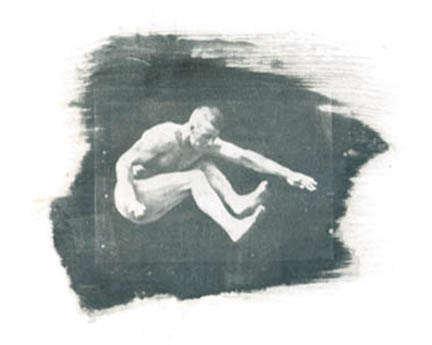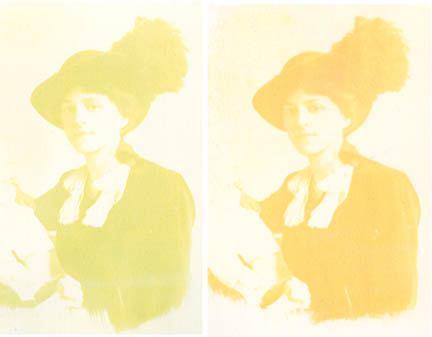
A scrap of paper was brushed from edge to edge with pigmented gelatin (colored with a reddish-brown powder to make the gelatin visible), dried but not hardened, then printed with gum pigmented with ivory black cooled with some blue. After the finished gum print was dry, hot water was poured across the face of the print. The unhardened red-brown gelatin in the light areas of the figure and in the border of the print (about two inches beyond the gum in every direction) dissolved completely in the hot water, without disturbing the hardened gum.
The dichromate in the gum printing process hardened the gelatin size underneath the exposed areas as well as the gum. The hardened gelatin is only obvious in the very edges of the brushstrokes on the left of the picture and a bit at the top, where the dichromate in the brush spread a little farther than the gum/pigment did, so at the very end of the brushstrokes you can see brown hardened gelatin by itself. (I hope this shows in the jpeg.) In the rest of the print, the presence of the hardened gelatin can only be inferred by the warm tone it adds to the black in the entire print, which would otherwise have a distinct blue cast as a result of the blue I mixed into it. (I used ivory black, a transparent pigment, so that the color of the underlying gelatin would show through.)
The hardened gum was not at all disturbed by the hot water; a paper towel used to wipe the water off the print, after the gelatin was washed away, was still pristine white after wiping across the gummed area (in other words it didn't pick up any black in the wiping).
Because the effect is subtle in the above image, and I'm not sure it even shows in the jpeg, I did another test where I used a lighter color for the gum color and show a print of that color mix without the colored gelatin, so you can see what the hardened pigmented gelatin underneath adds to the overlying color.

The image on the left is PY110 by itself at a rather heavy concentration, printed on gel-sized Fabriano Uno. The image on the right is Fabriano Uno sized with red-colored unhardened gel size, dried and then printed with gum colored with the same mix of PY110 as in the left image. (I should probably say pink rather than red for the gelatin; it looked deep red in the dish but the layer of gelatin on the paper was medium pink.) The finished gum print was dried and then hot water was run over to melt the unhardened gelatin. It should be clearer in this example than in the above example that the gelatin hardens with the gum, since the gum-gelatin print is considerably pinker than the yellow gum by itself.
A misguided gum printer has asserted that a gelatin size, unhardened, will react with the dichromate in the gum emulsion, causing the gelatin and the pigment in the gum emulsion (but apparently not the gum itself???) to harden into a solid color layer, making the formation of an image impossible. This is of course nonsense. Dichromate mixed with gelatin, or put in proximity to gelatin, doesn't cause the gelatin to crosslink any more than dichromate mixed with gum causes gum to crosslink. Only on exposure to UV does the crosslinking occur, in direct proportion to the exposure, and as demonstrated above, this happens with gelatin the same way as it happens with gum. This is the fundamental principle underlying the dichromated colloid processes; without it, dichromated colloid processes would not be possible.
All material copyright Katharine Thayer, all rights reserved.